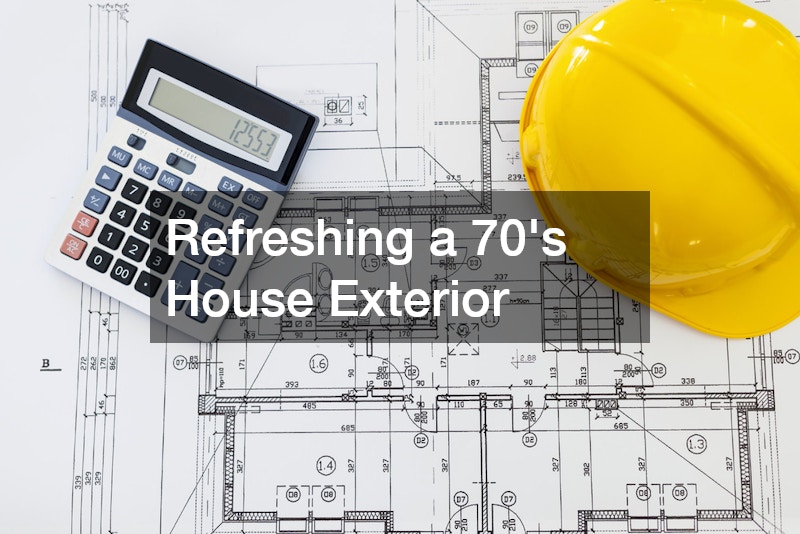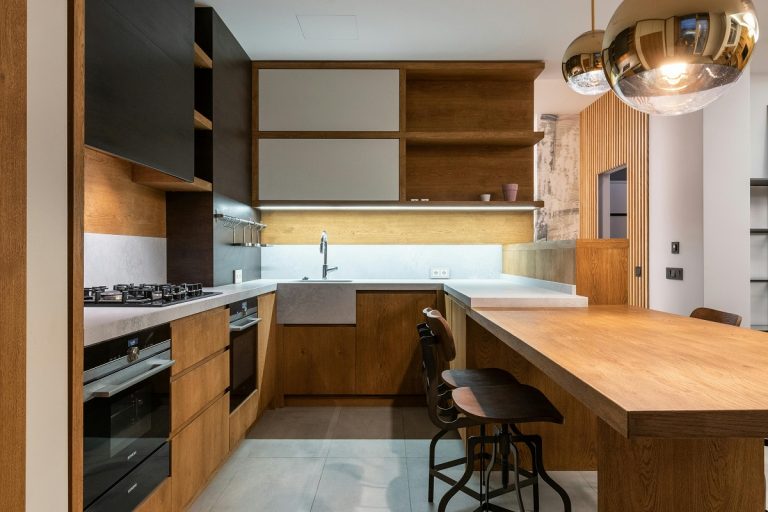

Homes built in the 1970s possess a unique character often rooted in bold lines, earthy tones, and minimalist design. While this era brought about some fascinating and forward-thinking architecture, many of these homes now appear outdated compared to modern aesthetic preferences. Fortunately, refreshing a 70s house exterior doesn’t require demolishing or completely starting over. With the right planning and updates, you can maintain the charm of the original structure while transforming it into a contemporary and visually appealing home.
What are the defining features of a ’70s house exterior?

Architectural Styles of the 70s
The 1970s were heavily influenced by modernism, with architectural styles such as ranch, split-level, and contemporary being dominant. Flat or low-pitched roofs, expansive windows, and rectangular forms were prevalent. These homes typically emphasized functionality over ornamentation, with open floor plans inside and a simplistic approach to exterior design. Many homes also featured finished lower levels, making basement waterproofing a critical concern for maintaining structural integrity and preventing moisture-related issues in these older builds.
Common Materials Used
Materials used in the construction of 70’s homes often included brick, wood siding, stucco, and stone veneer. Aluminum siding also made an appearance during this decade. Many of these materials were chosen for their affordability and ease of installation rather than durability or sustainability. Today, homeowners seeking to restore or replace aging exteriors often consult a siding contractor to explore modern siding installation options, including vinyl and fiber cement, which offer improved insulation and longer-lasting performance.
Color Palettes of the Era
The color schemes favored during the 1970s were earthy and warm. Tones like mustard yellow, avocado green, burnt orange, and various shades of brown were common. These hues gave the homes a grounded, natural appearance that blended with wooded surroundings and suburban neighborhoods. While these palettes created a cozy atmosphere in their time, refreshing them with modern colors can dramatically increase curb appeal and visual appeal.
Unique Design Elements
Architectural quirks such as decorative ironwork, angular rooflines, multi-level facades, and carports instead of full garages set 70’s homes apart. Brick planters, geometric paneling, and louvered wood detailing also added visual texture to many exteriors. Incorporating these elements in a refreshed way—or carefully removing and replacing them—can balance nostalgia with modern design goals. This is also an ideal time to evaluate foundational components and invest in needed repairs, including basement waterproofing if signs of moisture intrusion are present.
Comparisons with Other Decades
Unlike the more decorative homes of the 1950s or the open, tech-integrated designs of the 2000s, 70’s homes focused on simplicity, nature-inspired materials, and architectural innovation. Refreshing these homes means walking a fine line between preserving their historical charm and integrating modern amenities and style.
How can you update the exterior paint of a ’70s house?

Choosing Modern Color Schemes
Modernizing a 70’s house often begins with color. Today’s preferred palettes tend to be more neutral and minimalist, with hues like soft grays, off-whites, navy blues, and charcoal blacks. These colors complement newer roofing materials, modern trim, and landscape design, creating a cohesive visual that feels timeless rather than dated.
Preparing the Surface for Painting
Before applying new paint, it’s essential to thoroughly clean and repair any damage. Many 70’s homes have aged wood siding or stucco that may be cracking or deteriorating. Power washing, caulking gaps, and sanding down old paint are all crucial steps in preparing the surface to accept a new coat and ensure it adheres properly.
Selecting the Right Paint Type
Choosing high-quality, weather-resistant paint designed for exterior use is critical. In regions with fluctuating temperatures or humidity, investing in paint that resists mold, mildew, and UV rays can prevent the need for frequent touch-ups. This is especially important for homes that require more robust protection due to their orientation or older siding materials.
DIY vs Hiring a Professional
While painting can be a DIY project, hiring a professional may be wise for two-story or complex homes. Professionals can ensure even application, safe handling of high areas, and proper disposal of old paint. Plus, if the siding requires repair or replacement, it’s more efficient to have a siding contractor address these issues before painting begins.
Tips for Long-lasting Results
Proper surface preparation, use of quality primer, and choosing the correct paint finish all contribute to long-lasting results. Matte finishes can hide imperfections but may require more maintenance, whereas satin or semi-gloss finishes tend to be more durable and easier to clean.
What are effective ways to enhance curb appeal?
Front Yard Landscaping Ideas
Landscaping can significantly affect a home’s first impression. Hiring a local landscaper to create a custom plan that incorporates modern elements like raised garden beds, ornamental grasses, and curved borders can soften the linear appearance of a 70’s facade. Using native plants ensures easier maintenance and year-round beauty, and hiring tree trimming companies helps maintain safety and visual balance by managing overgrown branches and enhancing sunlight exposure.
Lighting to Highlight Features
Installing modern lighting such as LED pathway lights, uplighting for trees, and motion-detection porch lights can dramatically improve a home’s appearance at night. These fixtures not only add ambiance but also contribute to security and functionality.
Updating the Driveway and Walkways
Many 70’s homes still feature original concrete or gravel driveways. Working with asphalt companies to install an asphalt driveway can provide a cleaner, more modern look that also improves durability and ease of snow removal. Updating walkways with pavers or stamped concrete can further elevate curb appeal.
Modernizing Doors and Windows
Replacing old aluminum or wood-framed windows with energy-efficient models instantly boosts a home’s appeal and functionality. Likewise, updating the front door with a modern design—perhaps incorporating glass or sleek metal—can make a bold statement. A local garage door service can replace outdated garage doors with insulated and stylish models, completing the home’s transformation.
Adding Creative Decorations
Accent pieces like large planters, house numbers in contemporary fonts, and customized mailboxes contribute subtle yet impactful improvements. Choosing decorations that reflect the home’s overall style ensures a unified look and enhances visual appeal.
What modern roofing options are available?
Comparing Roofing Materials
Today’s roofing materials offer a wide range of options beyond the standard asphalt shingles common in the 1970s. Homeowners can now choose from metal roofing, clay tiles, and architectural shingles that provide aesthetic upgrades and improved performance. Asphalt companies often offer modern shingles that mimic high-end materials like slate or wood without the associated maintenance.
Energy-efficient Options
Cool roofing technology reflects sunlight and helps maintain indoor temperatures. Metal and solar-reflective asphalt shingles are excellent for energy-conscious homeowners. These options contribute to reduced cooling costs and increase the home’s sustainability.
Updating Roof Lines
Although it’s a larger renovation, altering the roofline can dramatically modernize a 70’s house. Adding dormers, extending eaves, or flattening slopes can give the home a completely different profile while improving attic ventilation and daylight.
Color Coordination with the Exterior
Choosing a roof color that complements the newly painted exterior is crucial for a cohesive design. Darker roofs can ground a light-colored house, while mid-tone grays and tans work well with modern neutral palettes.
Maintenance and Longevity
Newer roofing materials often come with 30–50-year warranties, making them a worthwhile investment. Regular inspections and cleaning will extend the life of the roof, while improvements such as better gutters can protect the home’s foundation, especially when paired with proper basement waterproofing.
How to modernize windows and doors?

Energy-efficient Windows
Upgrading to double- or triple-pane windows with low-emissivity coatings reduces energy loss and enhances comfort. These modern options also offer UV protection, noise reduction, and a sleek aesthetic that aligns with contemporary design standards.
Stylish Door Replacements
Replacing outdated front doors with modern designs made of steel, fiberglass, or glass can provide improved security, insulation, and curb appeal. These doors are available in various finishes and can be matched with side lights or transoms for added flair.
Incorporating Glass for Natural Light
Adding sidelights, transom windows, or even converting walls to sliding glass doors can introduce natural light and connect indoor spaces with the outdoors. These updates are particularly effective in ranch-style homes that originally emphasized outdoor living.
Security and Technology Upgrades
Smart locks, video doorbells, and motion-sensor lights offer modern convenience and peace of mind. Many homeowners also install smart garage openers, which a local garage door service can integrate with current security systems.
Harmonizing with the Overall Design
When choosing new doors and windows, it’s essential to ensure they complement the home’s existing lines, colors, and textures. Custom trim work and coordinated colors help unify the entire exterior.
What are sustainable renovations for a 70’s house exterior?
Using Environmentally Friendly Materials
Eco-conscious homeowners are increasingly choosing sustainable building materials like bamboo siding, reclaimed wood, and recycled metal. These choices reduce environmental impact and often offer unique textures and finishes.
Solar Panel Integration
Flat and low-slope roofs common in 70’s architecture are ideal for solar panels. Installing solar panels can offset energy costs and qualify for tax incentives, making this a smart investment for long-term sustainability.
Water Conservation Techniques
Installing rain barrels, drought-tolerant plants, and efficient irrigation systems can significantly reduce water use. Many local landscapers incorporate these features to create environmentally responsible and visually stunning yards.
Energy-efficient Insulation Solutions
Upgrading wall and attic insulation with modern, non-toxic materials can dramatically improve comfort and energy efficiency. These updates often accompany siding installation, making it cost-effective to complete both tasks simultaneously.
Recycling and Upcycling Elements
Reusing original materials like brick, ironwork, or wood beams helps preserve the home’s character while reducing waste. Creative repurposing of these elements can yield distinctive features that blend old and new styles seamlessly.
How to address structural issues in old 70’s homes?
Identifying Common Problems
Structural issues such as settling foundations, cracked walls, or outdated wiring are common in homes from this era. It’s vital to conduct a thorough inspection before beginning any major renovations.
Bracing and Reinforcement Strategies
If structural issues are identified, reinforcement with steel beams or additional bracing may be required. Foundation walls may need support to withstand moisture and soil pressure, especially in homes lacking modern basement waterproofing systems.
Dealing with Foundation Issues
Foundation cracks and moisture problems can lead to mold, structural weakness, and other complications. Employing specialists for basement waterproofing and foundation repair can prevent these issues from escalating.
Updating Plumbing and Wiring
Original plumbing and electrical systems often require modernization. Updating these elements improves safety and ensures compatibility with smart home systems and modern appliances.
Consulting with Structural Engineers
When in doubt, hiring a structural engineer is the best course of action. These professionals can assess risks and develop a plan for safe and effective renovations.
What landscaping changes can boost the look of a 70’s home?
Incorporating Modern Garden Designs
Contemporary garden styles that include geometric patterns, symmetry, and multi-level plantings bring fresh life to a dated yard. A local landscaper can design a layout that enhances the home’s lines while adding softness and texture.
Using Native Plants and Herbs
Native species thrive in local climates, require less maintenance, and support regional wildlife. These plants can be complemented with herbs and flowering bushes to provide beauty and function.
Building Outdoor Living Spaces
Decks, patios, and pergolas add usable space and enhance visual appeal. These features create a welcoming environment and can be designed to match the architectural lines of the house.
Creating Pathways and Retaining Walls
Paths made from stone, brick, or permeable pavers invite guests to explore the yard. Retaining walls using natural or recycled materials define garden beds and improve drainage.
Integrating Water Features
Small fountains, birdbaths, or reflective ponds can add tranquility and elegance. These features blend well with both retro and modern garden aesthetics.
How to incorporate technology into a 70’s house exterior?
Smart Lighting Systems
Automated outdoor lights that respond to motion or time of day can enhance both safety and curb appeal. They can be programmed to highlight specific features or adjust based on seasons.
Home Security Enhancements
Cameras, smart locks, and remote access controls improve security and peace of mind. Many systems can be integrated discreetly into existing architecture for minimal visual impact.
Using Technology for Energy Efficiency
Solar panels, energy monitors, and smart thermostats reduce energy use and provide real-time usage data. These tools help homeowners make informed choices about their consumption habits.
Integrating Automation for Convenience
Automated sprinkler systems, motorized awnings, and programmable lighting bring ease to exterior management. When connected to a central hub, these systems offer seamless control.
Sustainable Tech Upgrades
New technologies focused on sustainability include gray water systems, rain sensors, and efficient HVAC units. These upgrades future-proof the home while promoting responsible living.
What are budget-friendly updates for a 70’s house exterior?

DIY Decoration Tips
Painting trim, replacing hardware, and adding homemade planters are inexpensive ways to improve the exterior. These small updates can have a big impact with minimal cost.
Affordable Material Alternatives
Opting for cost-effective landscape materials like gravel paths, mulch beds, or concrete pavers can stretch your budget while still delivering style and durability.
Using Paint for a Quick Change
A fresh coat of paint on shutters, railings, or the front door can transform the exterior instantly. Choosing modern, complementary tones enhances overall visual appeal.
Thrifty Landscaping Tricks
Partnering with local landscapers for seasonal discounts or doing your own lawn care can reduce costs. Many also recommend tree trimming companies for one-time services that enhance both safety and aesthetics.
Leveraging Sales and Discounts
Buying in bulk or waiting for seasonal sales on items like siding, paint, or outdoor furniture can significantly reduce expenses. Many siding contractors offer promotional pricing during off-peak seasons.
Closing Thoughts
Revitalizing a 70s house exterior is a rewarding project that combines preservation with innovation. From upgrading siding and roofing to embracing modern landscaping and smart technology, there are numerous ways to enhance the look, functionality, and sustainability of your home. Whether you take a DIY approach or hire professionals for tasks like siding installation, basement waterproofing, or working with asphalt companies and tree trimming services, the result can be a beautiful blend of vintage charm and contemporary style.


